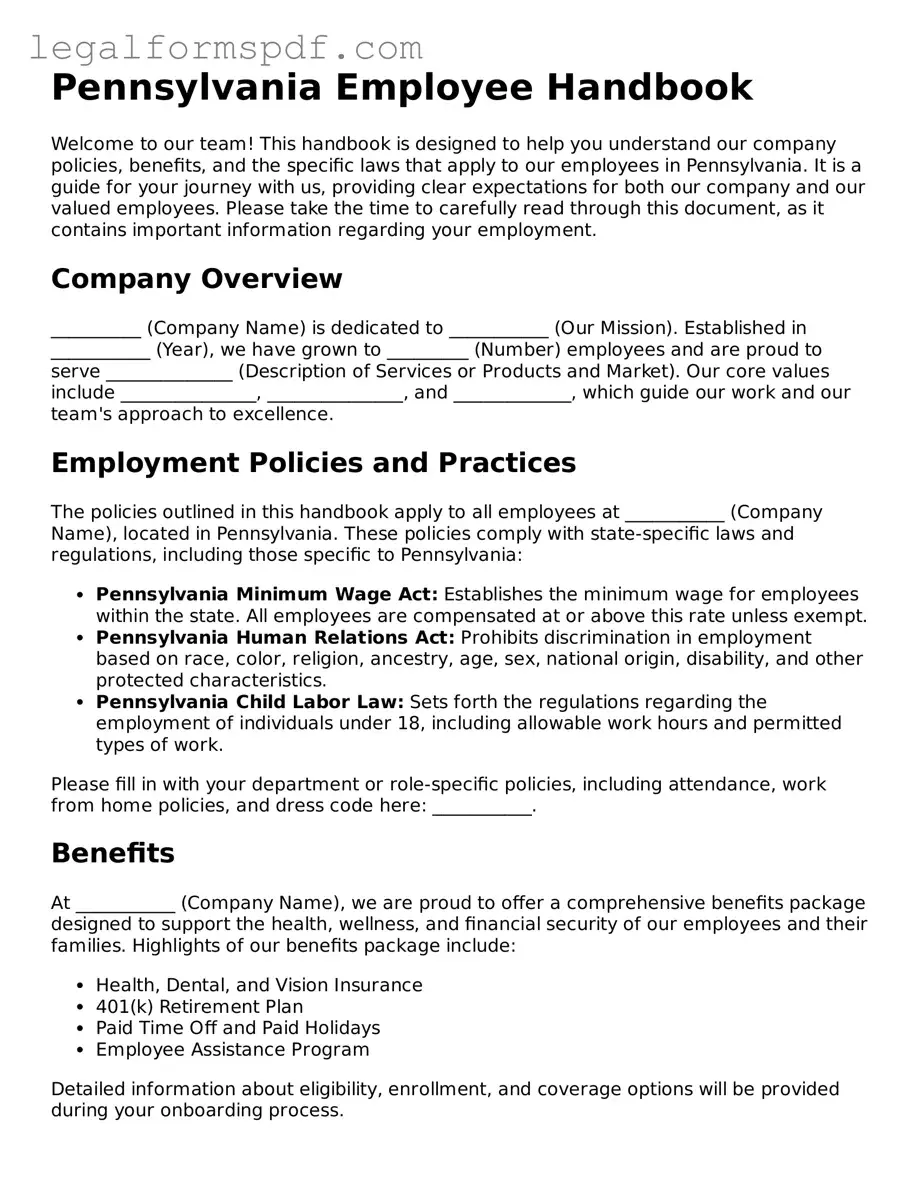Pennsylvania Employee Handbook
Welcome to our team! This handbook is designed to help you understand our company policies, benefits, and the specific laws that apply to our employees in Pennsylvania. It is a guide for your journey with us, providing clear expectations for both our company and our valued employees. Please take the time to carefully read through this document, as it contains important information regarding your employment.
Company Overview
__________ (Company Name) is dedicated to ___________ (Our Mission). Established in ___________ (Year), we have grown to _________ (Number) employees and are proud to serve ______________ (Description of Services or Products and Market). Our core values include _______________, _______________, and _____________, which guide our work and our team's approach to excellence.
Employment Policies and Practices
The policies outlined in this handbook apply to all employees at ___________ (Company Name), located in Pennsylvania. These policies comply with state-specific laws and regulations, including those specific to Pennsylvania:
- Pennsylvania Minimum Wage Act: Establishes the minimum wage for employees within the state. All employees are compensated at or above this rate unless exempt.
- Pennsylvania Human Relations Act: Prohibits discrimination in employment based on race, color, religion, ancestry, age, sex, national origin, disability, and other protected characteristics.
- Pennsylvania Child Labor Law: Sets forth the regulations regarding the employment of individuals under 18, including allowable work hours and permitted types of work.
Please fill in with your department or role-specific policies, including attendance, work from home policies, and dress code here: ___________.
Benefits
At ___________ (Company Name), we are proud to offer a comprehensive benefits package designed to support the health, wellness, and financial security of our employees and their families. Highlights of our benefits package include:
- Health, Dental, and Vision Insurance
- 401(k) Retirement Plan
- Paid Time Off and Paid Holidays
- Employee Assistance Program
Detailed information about eligibility, enrollment, and coverage options will be provided during your onboarding process.
Employee Conduct
At _____________ (Company Name), we expect all employees to conduct themselves in a manner that reflects our core values. This includes adherence to ethical standards, respect for all colleagues, and a commitment to quality in everything we do. Any form of workplace harassment, discrimination, or violence is strictly prohibited and will be met with appropriate disciplinary action.
Confidentiality and Data Protection
Protecting confidential company information and personal data of employees and clients is a top priority. All employees are responsible for maintaining the security of sensitive information, following company guidelines, and adhering to applicable laws, including the Pennsylvania Data Protection Acts.
Acknowledgement
By continuing your employment with us, you acknowledge that you have received, read, and understood the contents of this handbook. Furthermore, you agree to abide by the policies and practices outlined herein.
___________ (Employee Name) ___________ (Signature) ___________ (Date)
This handbook is subject to updates and revisions. Employees will be notified of significant changes. However, it is the responsibility of each employee to stay informed about policy updates.
If you have any questions or need further clarification, please do not hesitate to contact our HR department at ______________ (HR Contact Information).
